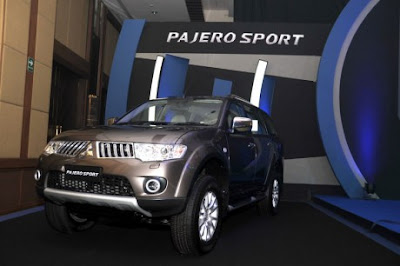
Though the new Shogun does a fair impression of a metrosexual, road-biased modern soft-roader, that atmospheric pressure readout in the centre console stands out like a crap-encrusted welly poking out the bottom of a smart suit. Dressed up in new clothes it may be - the facelifted Shogun gets a new front end that manages to be bluffer yet sharper at the same time - but this is still a river-wading 4x4 from the muddy old school. And better for it.
There is added grrr and green in the engine department. The 3.2-litre four-cylinder diesel has been revised, with power up to 197bhp, torque rising to 325lb ft and CO2 emissions dropping from 280g/km to a passable 224g/km. Consumption is improved by 5mpg. Of big SUVs, only the BMW X5 is cleaner.
With vital statistics like that, you'd be forgiven for lumping the new Shogun in with the modern breed of puddle-dodging faux-by-fours... until, that is, you start it up. At this moment, any delusions of a silky BMW-spec diesel disappear into the throaty rumble of the engine.
It'll haul the Shogun at a passable lick - 11 seconds to 62mph - but it won't do it with much enthusiasm. It will, however, enthusiastically pull large things out of bogs. TopGear has never been much concerned with towing capacity, but we are delighted to discover that the Shogun will haul a mighty 3,500kg. What is 3,500kg in hauling terms?
Well, it's plenty enough to drag a rogue cow from a peaty bog. Or a World War One tank come to that. The more expensive Toyota Land Cruiser will tow a pitiful 2,800kg. We imagine towing capacity to be important currency in the sort of grizzled, flinty pubs where Shogun and Landcruiser drivers drink.
As are things like front and rear overhangs, and maximum climb angles, and low-ratio gearboxes - stuff the Shogun does better than almost anything out there. Even this seven-seat version will tackle a 48° incline without breaking sweat. That's more or less upside-down.
The X5 or XC90 may defeat it over tarmac, the Discovery may offer a better balance of on- and off-road ability, but if your daily commute includes mamba-infested swamp and a plunging ravine with a dozen logs in tow, the Shogun is what you need. And those greener engine revisions mean you'll get deeper into the inky wilderness before reaching for the jerry can.
Specification
Cost
Price according to DAFTAR £ 37.999
There is no data transmission charges
12 Months Road Tax £ 125
Insurance group 16a
Running Costs (per mile) There is no data
Achievement
Maximum Speed (MPH) There is no data
0-60 MPH (Seconds) 0
Liters / 100 km (city) 9
Liters / 100 km (extra-urban) 9
Liters / 100 km (COMBINED) 11
Miles per gallon (urban) 22
Miles per gallon (extra urban) 31
Miles per gallon (COMBINED) 27
Emission
20 Euro emission standards
Carbon dioxide (CO2) 224
Technical
Door Number 5
Cubic capacipty (CCS) 3.200
Brake horse power (BHP) 197
Number 4 cylinder
DOHC camshaft
Number valve 4
Consumption of diesel fuel
Aspiration Turbocharged Fuel
Direct Injection Fuel Delivery
Especially Wheels Four Wheel Drive
Numbers Speed 2x5 teeth
Use Automatic Transmission















































